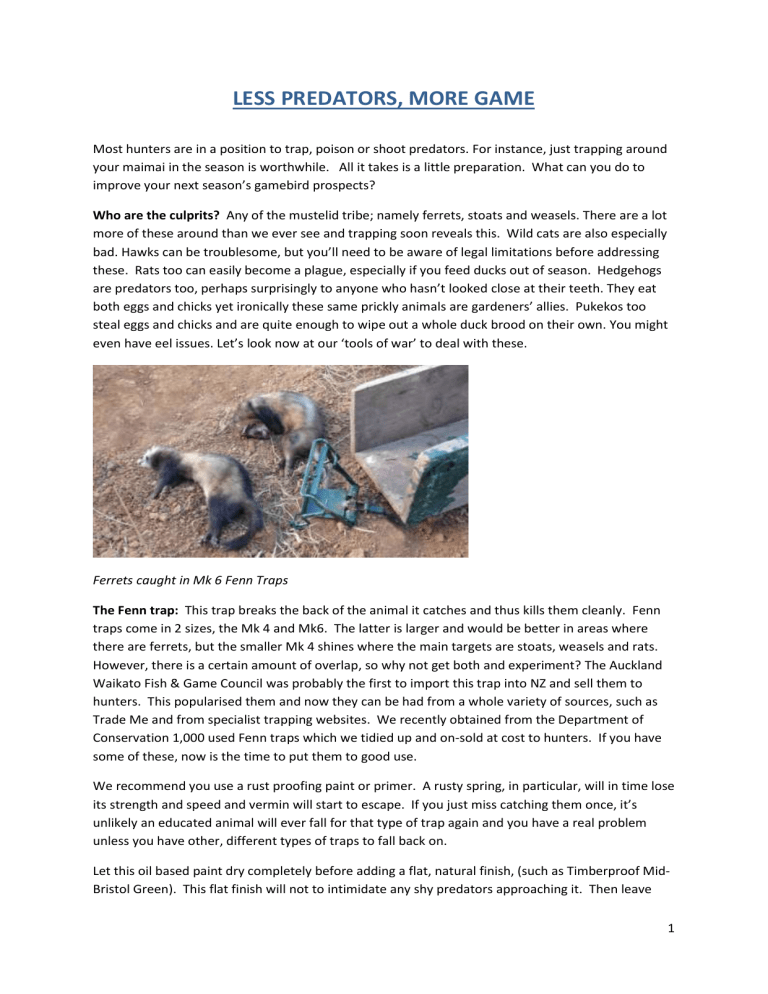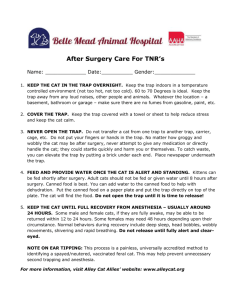Predator trapping - Auckland / Waikato Region

LESS PREDATORS, MORE GAME
Most hunters are in a position to trap, poison or shoot predators. For instance, just trapping around your maimai in the season is worthwhile. All it takes is a little preparation. What can you do to improve your next season’s gamebird prospects?
Who are the culprits? Any of the mustelid tribe; namely ferrets, stoats and weasels. There are a lot more of these around than we ever see and trapping soon reveals this. Wild cats are also especially bad. Hawks can be troublesome, but you’ll need to be aware of legal limitations before addressing these. Rats too can easily become a plague, especially if you feed ducks out of season. Hedgehogs are predators too, perhaps surprisingly to anyone who hasn’t looked close at their teeth. They eat both eggs and chicks yet ironically these same prickly animals are gardeners’ allies. Pukekos too steal eggs and chicks and are quite enough to wipe out a whole duck brood on their own. You might even have eel issues. Let’s look now at our ‘tools of war’ to deal with these.
Ferrets caught in Mk 6 Fenn Traps
The Fenn trap: This trap breaks the back of the animal it catches and thus kills them cleanly. Fenn traps come in 2 sizes, the Mk 4 and Mk6. The latter is larger and would be better in areas where there are ferrets, but the smaller Mk 4 shines where the main targets are stoats, weasels and rats.
However, there is a certain amount of overlap, so why not get both and experiment? The Auckland
Waikato Fish & Game Council was probably the first to import this trap into NZ and sell them to hunters. This popularised them and now they can be had from a whole variety of sources, such as
Trade Me and from specialist trapping websites. We recently obtained from the Department of
Conservation 1,000 used Fenn traps which we tidied up and on-sold at cost to hunters. If you have some of these, now is the time to put them to good use.
We recommend you use a rust proofing paint or primer. A rusty spring, in particular, will in time lose its strength and speed and vermin will start to escape. If you just miss catching them once, it’s unlikely an educated animal will ever fall for that type of trap again and you have a real problem unless you have other, different types of traps to fall back on.
Let this oil based paint dry completely before adding a flat, natural finish, (such as Timberproof Mid-
Bristol Green). This flat finish will not to intimidate any shy predators approaching it. Then leave
1
these traps someone safe in the weather, (away from kids, such as on a shed roof), so any remaining paint smell completely cures off. Zinc-plating traps will, unfortunately, affect spring strength and is not advised. However, the latest Fenn traps are being offered powder-coated green. The trigger parts on the trap should have their paint cleaned off so these plates slide naturally. If you want to use oil on the hinges, it’s suggested you avoid motor oil and use something more natural like a few drops of olive oil.
Mk 6 Fenn Trap set in a tunnel
The Fenn trap is only ever used in tunnels, to prevent unwanted catches. Usually there’s one trap each end. The trap chain is stapled to the outer edge of these tunnels of about 600 mm length. The tunnel height needs to be just enough that, when the trap is sprung, there is little headroom above it
– but not so little that the trap can’t close. This height ensures the stoat is pinned to the roof as the trap closes on it, and is not thrown clear. The traps are placed in a shallow impression in the ground as there is no floor in the 3-sided tunnel. This means, to the animal running into the tunnel, there is nothing unnatural projecting up to have to jump over. The trap need not be covered in soil or leaves, though some gamekeepers do so with a very light covering. If the trap hasn’t caught in a few weeks, it’s not a bad idea to spring it and in doing so shake out any accumulated leaves and rubbish that might interfere when it is set off by vermin.
Practise setting the Fenn in such a way that your fingers are never inside the trap. That way you can set the plate and apply the safety-catch as often as you like, and still play the piano! When the
Fenn is in its tunnel, release the safety with a small stick. DON’T forget. If an animal springs the trap, but it then catches on the forgotten safety, you’ll probably never fool this animal again and it’ll live among your traps, killing your ducks, with impunity.
The trap’s plate needs to lie even when the trap is set. It can be bent over a screw-driver just behind the plate if the plate is too high, or bent up if it is too low – all with the safety catch on, of course.
Set the plate lightly as a female weasel only weighs a few ounces. Some gamekeepers bait with meat under the plate, others in the middle between the two traps. If you have weasels in any number,
2
(and they are limited in distribution in NZ), one suggestions is to skewer the meat bait on a nail, so that the animal has to really tug at it to get it free, digging into the trap plate with their back legs while doing so.
Tunnels can warp, so use fairly tick timber, well nailed or screwed, to counteract this. It’s not a bad idea to have a wooden brace or two across the middle of the base to keep the sides apart at the right distance. Use treated wood and, once again, weather the completed tunnel first to lose any unnatural smells.
Box trap: Regular baiting isn’t essential, though it will much improve catch rates
Tunnels are interesting to predators in their own right, something to be checked out to see if there’s a prey animal living in it. So regular baiting isn’t essential, though it will much improve catch rates.
Look for places that predators like to use as a runway. For instance, alongside the outside wall of a hayshed is good, because mice and rats live in the shed, especially in autumn/winter for food and warmth, and these attract mustelids. Cover the trap tunnel with a bit of old roofing iron, plywood, weatherboard, etc, leaning this cover up against the wall and you have a great sett. Another good site is a gap in a hedge, in a dry drain or dry culvert or next to a gateway. The theory is that the mustelid rushes past the open gateway to get back into cover again – your tunnel! You can also put them next to a log, a stone wall or among timber or rubbish piles.
A network of traps should be laid out in likely places, traps numbered and a trapping log kept. You will soon see which aren’t working and relocate them hopefully to a better place. Sometimes the first catch is all they need to start working afterwards, so don’t be too quick to shift them if the site seems to have merit. The network should not take you too far out of your daily round. There’s no point having to make a long detour just to check one empty trap. Obviously, you’ll want to surround a feature like a pond to catch newly arriving predators before they settle in. Remember predators, in particular mustelids, have large home ranges and ideally you want to have traps canvassing a large area around the site of interest. Having just one or two traps around a large pond will likely be insufficient at controlling most predators, but it’s better than none.
If you decide to bait the traps, good baits include rabbit or hare liver and/or the flesh of these animals. Fresh hen or bantam eggs also work well. Meat baits go off quickly in the warmer months
3
and will need frequent replacing, say once a week. It may take a few days for your human scent to leave the traps and bait, so give them a wee while to work. For this reason, avoid any scents such as soap, not to mention chainsaw fuel, diesel and suchlike if you’ve been handling these beforehand.
Clean your hands normally, but then rub in some soil and/or leaves to mask any remaining smell.
You might also consider using rubber gloves. One British researcher learned from a gamekeeper to mix some rabbit gut contents with water in a bucket and then sprayed this at tunnel entrances using a small squeeze-trigger sprayer, (the sort of thing a hardware store sells for under $10). She froze the remaining mix in blocks for later use. Her catch rate went up about 4-fold. A New Zealand researcher said he did this too and caught many more ferrets than his fellow workers did.
Be especially careful that your dog doesn’t piddle on the trap. That really won’t help. Fenn tunnels usually have 2 stout sticks knocked into the ground either end to dissuade dogs from putting their noses in and also to guide the target animals directly over the plate. The ground leading up to the tunnel should be cleared of grass, firstly because bare earth attracts predators who think it may be a rabbit burrow, but also because “a clean entry means a clean catch”. Always keep that phrase in mind.
DoC 250 trap
DoC 200 and 250 traps: These New Zealand inventions are not unlike the Fenn trap but with a stronger spring. They come in a variety of sizes and, probably for liability purposes, they also come mounted inside stout wooden boxes that can only be opened with a power-drill. They have 2 mesh layers with small openings for a predator to get past, and this eliminates any accidental by-catches as well as minimising any curious humans from putting their hands in. Somehow even quite large hedgehogs squash down to gain entry through these small holes. You can make up an egg-holdingcup from timber screwed into the far end of the trap so as to lure predators over the plate. You can also use meat baits. Eggs should be replaced every week or two, though sometimes they’ll act as a sight, (rather than smell), bait and will continue to catch long after this. I suppose it depends how hungry the predator is. Some trappers say that a few feathers, for instance from a duck, sprinkled in and around the trap helps lure predators in. Most trappers say that you can’t beat fresh rabbit for mustelids and cats but fish, (fresh or smoked), eggs and poultry all work so experiment with different baits.
4
Box and cage traps: It is possible to buy wire-mesh cage traps for mustelids, rats and hedgehogs from certain sports shops. These are like the old possum cage but are quite a bit smaller and use a treadle to release the door. A meat bait behind this will soon test what is around. Once you’ve caught something, the next question might be; what now? An air rifle or air-pistol is fine for dispatching such animals. You can also simply drop it in water to drown them and a cattle-trough will do the job at a pinch. A third option is to put the whole trap into a grain bag and then apply this to a cold vehicle exhaust pipe. If you decide to release the animal for a dog to dispatch, don’t be the least surprized if they escape. It probably also violates several humane laws and codes of practise besides!
Box traps can be made from timber. The best have a door both ends so that the wild cat or whatever thinks it’s safe to go inside. But when it pulls on the bait, which could be a smoked fish tail, for instance, it sets the trap off and both doors fall at the same time. These traps have a wire mesh section on their roof that, when the cover is pulled back, allow an air rifle to be used to dispatch the animal inside. AWF&GC can supply plans for DIY trappers.
Timber box trap
If there’s a small stream in the area you trap, consider providing predators with a bridge over it, either a tree truck or a wooden plank bridge, with the open-both-ends box trap, (or Fenn tunnel) in the middle. A treadle style of box-trap release works best in these situations, if it sets off from either direction. If you put a box trap alongside something that guides the animals into it, such as alongside a wire-mesh fence, or a stone wall, even just alongside a fallen log, so much the better.
You can also use stakes in the ground and branches woven into them to make a funnel that leads the animal into the trap entrance and makes it harder to avoid it once they’re on that track. Again, a clean entry to the trap ensures a clean catch.
Poison: Especially if you’re feeding ducks, rats will become a problem. Even when feeders are mounted over water, the rats can dive and retrieve grain. It’s a good idea to lay poison nearby the feeding area but rats can sometimes drop poison they’re taking to hoard away and gamebirds can then eat it, so what’s the simple answer? Firstly, it’s good practise to use a rat poison box, which is a
5
box with a small entrance both ends – too small for ducks to enter. The box is divided into 2 with a low wall in-between and the poison grain goes at the back. So a bird can’t readily put its head in and help itself. Most rat baits these days have a hole in the middle so that the bait can be nailed to the box or better, anchored with wire, to prevent rats removing it. Because they have to eat it there and then, this ensures it’s not taken away and hidden from other rats and you’ll target the whole local population that way. It’s good practise to clearly stencil this box “poison” in red paint and also to lock it besides with a small child-proof padlock. Initially the poison may seem to disappear at an alarming rate, but after a while you’ll break the back of the local rat population and thereafter it’ll just need maintenance top-ups. If you’re on a budget, try putting the poison inside a Fenn tunnel to act as a rat attractant. You’ll get multiple catches per individual bait.
Shooting: Trapping will reveal that there are many more mustelids, rats and hedgehogs around than you would ever credit from simple observation. The fact is these animals keep a very low profile.
You can also test this by leaving a few gamebird carcasses around, for instance, breasted birds, and see just how quickly they disappear – usually overnight. A sitting (i.e nesting), duck has to survive this threat for weeks on end.
Not likely to come back!
If your dog should flush a wild cat when you have a gun in your hands, don’t spare the cartridge. The worry is, of course, it could be someone’s pet. If it’s several hundred meters away from anyone’s house, it’s almost certainly wild besides which, it’s certainly up to no good. It’s not a bad idea to find out what your neighbour/s cat/s look like, just in case “Binty” turns up at the pond edge one day.
Then you can still look your neighbour in the face and remain good friends. We have tried many tricks to teach a tame cat caught in a cage not to come back, such as playing a hose on it then letting the dog chase it, (after a safe head-start, that is). However, as miserable as they look at the time, they typically come back within just a few days. They’re quite incorrigible. To date no wild cat we’ve shot has ever repeated their offending.
Pukeko will kill off an entire brood of ducklings and there’s really only one way to stop this sort of thing. Relocating them has been tried – up to 80km away, but failed when these birds all returned,
(because they were banded after capture, there was no question they were the same ones). So use the 4-month long pukeko shooting season to control them in areas where this sort of conflict is
6
taking place. They’re not to be despised as gamebirds either and you can have a lot of sport trying to outwit them. If you haven’t found the perfect pukeko recipe yet, some hunters report that pooksoup definitely has its merit.
Hawks can be caught in ladder-traps, the design of which can be found online. They’re also attracted to pukeko and breasted duck carcasses left somewhere you can readily sneak up on them, such as just past a hedge, or around some sort of corner. However the legal status of hawks poses more than a few problems if you’re losing ducklings hand over fist to them. The Fish & Game NZ website contains a summary of what you can and cannot currently legally do. Please stay on the right side of the law by reading it first.
Important to keep the pook population under control
Improving your odds: A trap will only attract animals from the immediate area, for instance, those that come into range of the bait’s smell. This can be improved upon considerably by using a drag - either a dead rabbit or duck carcass, etc. Cut open the gut cavity and some of the gut itself. Then pull it around the paddock on a piece of string so that it leaves a distinct trail. You can do this on foot but even better is a farm bike, because the rabbit bounces up and down leaving bits of gut behind. Make sure you pull it towards the trap and do the same from at least one other direction.
Any predator that hits this trail will follow it, perhaps several hundred meters, into the trap. One day a stoat was seen on a farmers’ front lawn. Using this trick the Fish & Game officer had it caught by the next day, in a Fenn tunnel set beside the nearby barn.
By the way, if you get some rabbit gut on your hands, it’ll come off if you wash them with a bit of meth’s, then soap. Repeat in 30 minutes as it’ll work out of your skin pores as well. Particularly if you’re going out on a hot date that night, suggest instead you use thick rubber gloves to field dress the bunny. One European gamekeeper told us that, if he catches a female mustelid, he squeezes her bladder over the trap and catches any love-sick males in the area. But if he catches a male, he pulls its tail back hard and wipes its’ bottom on the upper, inner tunnel entrance. This is where the animals’ musk glands are. The way he descried it was thus: Mustelids patrol their territory for interlopers. Imagine you came home and smelled strange cigarette smoke coming from your wife’s bedroom. Would you hesitate to investigate?
Some say that a largish feather suspended on a piece of string in the breeze above a box trap will attract wild cats who’ll come to investigate it – a sight lure. Cat biscuits also have a role to play as
7
bait with the advantage they last longer than meat baits. Old baits will attract hedgehogs, as much for their insects on them as the meat itself. Hedgehogs struggle with large hen eggs, but anything smaller is at their mercy and quail especially, (but perhaps also ducks or pheasants), will not thrive in their presence.
Possums may not seem to be a threat to ducks, but they occupy duck nest boxes and also natural nest cavities in trees that ducks might otherwise use. They also do major damage to food-bearing trees that are being planted for the benefit of game. In short, they’re a real pest. Timms traps,
(square, yellow plastic traps), are a kill trap that is especially easy to use for possums. Even granny’s use them. You can also bait them with meat skewered onto the trigger to catch ferrets and wild cats. However fruit works best with possums. The freshly killed possum will then attract other predators so why not use this to your advantage? Suggest you tie this bait to something so it doesn’t get carted away. Put it where you can easily ambush it, then sneak up on the carcass some hours later with a shotgun and be ready for a quick snap shot at what’s feeding on it. You can also try this trick at night using a spotlight and a varmint rifle such as a .22 rimfire or a .22 Hornet. Some hunters pre-feed for several nights, then suspend a dead possum just out or reach from a tree branch. When they play their spotlight beam on it late in the evening, there’s often 2 or 3 wild cats taking turns trying to try to pull the carcass down.
When should I trap and for how long? Animals have clever ways of working out if their neighbour isn’t around any longer. For instance, if they’re a species that scent marks, and that marking has gone stale, they know old Charlie is no longer in residence. So they naturally move in. For this reason, you can’t really blitz an area, and then enjoy several years of low predator numbers. It’s a never ending task. But if you are limited as to time, then the best time is just before and during the breeding season. Even if you’re only in the field for a few days each year, for instance, the weekend you tag and tidy up the maimai and opening weekend, why not set a trap or 4 overnight and see what’s there the next day? Every predator caught counts. By law, you need to check traps every 24 hours they’re set. However, there’s no law against leaving a trap on safe inside its tunnel, so that animals routinely run over the top of it. Then, when you can come back next time, set it up to catch those critters which have by now have lost all caution of it. This is really effective if the tunnel offers a quick or easy way to get from point-A to point-B, for instance, on a plank over a wide ditch.
Trapping can be a challenging and rewarding activity in itself – not least when you see how many more gamebirds you have successfully bred, for instance, on your farm, lifestyle block or pond as a result. Keep an eye open too for annual competitions where you could win good prizes for your trapping skills.
Good luck.
8
9








